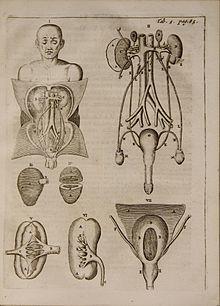Johann Vesling (Latin: Veslingius) (1598 – 30 August 1649) was a German anatomist and botanist from Minden, Westphalia.
In his youth he came to Vienna together with his father, where he later studied medicine. In 1628 he was applied as an "Incisor" at the medical college in Venice. In the same year he traveled to Egypt and Jerusalem, where he was the personal physician of the Venice consul, and also conducted extensive studies of regional flora (particularly medicinal plants). His botanical studies lead in 1640 to the publication of an annotated edition of De plantis Aegypti first published by Prospero Alpini in 1592, and to a work on balsam published in 1644.[1]
In 1632 he became professor of anatomy and surgery at Padua, where he was an instructor to Thomas Bartholin. Later in his career, he succeeded Prospero Alpini (died 1616) as director of the botanical garden at the University of Padua.
Vesling is remembered for the 1641 publication of Syntagma anatomicum, publicis dissectionibus, in auditorum usum, diligenter aptatum, a popular textbook based on his anatomical dissections in Padua. In this work he provided an early discussion of the human lymphatic system. Vesling also performed important studies of blood circulation, and was one of the first physicians to describe the brain's circle of Willis.
References
- Heirs of Hippocrates Johann Vesling
- Specific
- ^ Vesling, Johann (1644). Opobalsami veteribus cogniti vindiciae. Padua: typis Pauli Frambotti bibliopolae.
